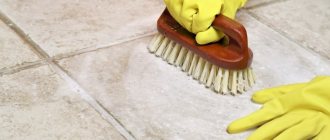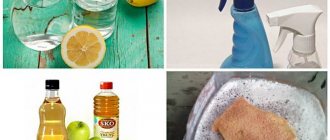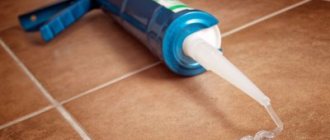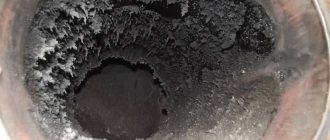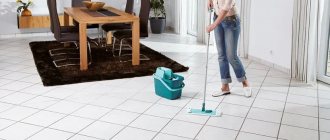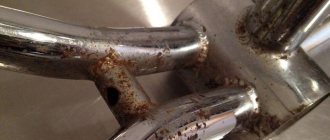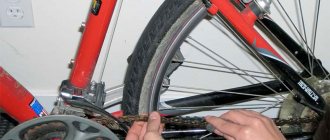Ceramic tiles are easy to care for. It is enough to wipe it regularly with a damp cloth.
But what to do when rusty streaks appear on the perfectly smooth surface of ceramic tiles? Answer: without delaying the cleaning process, choose a method for removing rust stains and begin the process.
We will tell you in this article how and what to use to remove rust from tiles.
Folk remedies
It is possible to remove rust stains from tiles using improvised means. There are a sufficient number of folk methods to help clean tiles quickly and efficiently.
How to scrub with hydrogen peroxide solution?
Hydrogen peroxide will help remove fresh rust stains on tiles.
It's simple: rusty stains are generously moistened with peroxide and left for ten minutes . Afterwards, wipe off the dirt with a damp cloth or sponge.
If the rust stain has already become embedded in the surface of the ceramic tile, a solution of hydrogen peroxide (50 ml) is mixed with baking soda (2 tsp) and liquid soap (1 tsp).
Rub the prepared mixture onto the stain and leave it for ten minutes. Afterwards, thoroughly wipe the tiles with a clean, damp sponge .
A mixture of vinegar and baking soda
Simple, accessible baking soda and acetic acid are effective means of combating rust stains on tiles.
Algorithm of actions:
- A soft sponge is soaked in a vinegar solution and sprinkled with baking soda.
- As soon as the components, having combined, enter into a chemical reaction (foam and a characteristic hissing sound appear), thoroughly wipe the rust stain with a sponge.
- The already cleaned surface is washed with clean running water.
The product is effective for fresh stains. For stubborn rust stains, cleaning with a mixture of soda and vinegar will have to be repeated several times.
Lemon and table salt
Products that every housewife has in her kitchen - lemon and salt - will become an indispensable tool in the fight against red plaque on tiles.
Algorithm of actions:
- Apply fresh lemon juice to a rust stain on a tile;
- after fifteen minutes, table salt is poured onto the contamination (it is important that the salt is of extra class with the smallest granules);
- After the salt has completely dissolved in the lemon juice, wipe the stain gently with a sponge or remove it with a napkin.
It is necessary to ensure that the salt granules dissolve completely. Otherwise, scratches and abrasions will remain on the tile.
Cream of tartar powder
A natural, environmentally friendly rust remover is cream of tartar powder. It can be purchased at a grocery store (very often housewives use cream of tartar powder as a baking powder for baking).
Algorithm of actions:
- The rust stain is thoroughly moistened with hydrogen peroxide.
- Cream of tartar powder is poured onto the still damp surface.
- Wipe off the dirt with a damp soft sponge, then wash off the remaining cream of tartar with clean warm water.
To maintain the gloss of your ceramic tiles, wait until the cream of tartar powder granules have dissolved in the hydrogen peroxide before scrubbing the stain with a sponge.
How to remove hydrochloric acid?
You can achieve ideal tile cleanliness by using a hydrochloric acid solution for cleaning.
Algorithm of actions:
moisten a piece of cloth in a solution of hydrochloric acid, which is used to cover the rust stain on the ceramic tile;- after twenty minutes, the fabric is thrown away, and the rusty coating (which has become loose from the acid) is carefully removed with a silicone scraper;
- Additionally, the cleaned area is washed first with a soap solution and then with clean warm water.
Work with hydrochloric acid is carried out only in a well-ventilated area, using protective equipment (gloves, respirator, safety glasses). If hydrochloric acid gets on your skin, it must be washed off immediately with plain water.
What determines the difficulties in cleaning ceramic tiles from rust?
The tactics for removing rust from a tile surface depend on the nature and complexity of the contamination, as well as the type of tile surface. From a glossy surface, fresh rust stains can simply be wiped off with a damp cloth. Stains that have frozen and are partially absorbed into the glaze will be a little more difficult.
The biggest challenge will be removing rust from matte tiles. Here, most likely, you will have to use cleaning products, and more than once. In general, the older the rust stains, the more difficult they are to remove from a ceramic surface.
The design of the tiles should also be taken into account - are they background tiles or decorative tiles? The decorative design can be easily damaged, especially when it comes to budget tile samples. This significantly narrows the range of rust removal methods that can be used.
Remove rust from tiles using lemon and salt
Another symbiosis of available tools from the arsenal of any housewife.
Dissolve citric acid in a glass of water. Moisten the rust stain generously with citric acid (you can also use freshly squeezed lemon juice) Wait 10-15 minutes until the rust begins to soak and move away from the surface of the tile. Next, sprinkle finely ground salt onto the treated areas. And begin to rub off the rust with light circular movements.
You should be aware that this method may have a negative impact on the tiled design. It is better to choose it for working with background tiles.
Remove rust from tiles with hydrogen peroxide
Another frequently used remedy. First of all, try moistening the contaminated tile surface with peroxide solutions, wait a while, and wipe with a napkin. If this does not help, then in addition to peroxide, you can also use additional means: liquid soap, baking soda, salt.
Fill 1/4 cup with hydrogen peroxide, add one teaspoon of liquid soap, and 1/2 tablespoon of baking soda. Mix the resulting composition. Apply the mixture to the stains and leave for 5-10 minutes.
If necessary, the procedure can be repeated.
Special formulations
As a replacement or in addition to folk remedies, special chemical compounds are used to combat rust stains. TOP 3 most popular and effective:
- Anti-rust gel Sanita . Directions for use: apply the product to the stain, leave for ten minutes, then rinse with warm water. The average cost of Sanita Anti-Rust gel is 90 rubles. (500 g bottle).
- Luxus Professional . Directions for use: Spray the product onto the rust stain and leave for fifteen minutes. Afterwards, wash off the treated surface with warm water. If the stain cannot be removed the first time, treat it with the spray again, wait the allotted time, gently wipe with a soft brush, and then rinse with warm water. The average cost of Luxus Professional is 125 rubles. (500 ml bottle).
- Clean Drops rust remover is an excellent option for cleaning not only tiles, but also natural stone surfaces. The product can be used both for household cleaning and for cleaning tiles laid on the facade of the house. The average cost of Clean Drops for rust is 1000 rubles. (per package 5 l).
Cleaning using any chemical agent is carried out only in a well-ventilated area using personal protective equipment (gloves).
This video will show you how to remove rust stains from tiles using phosphoric acid:
General rules
Rust occurs from the interaction of oxygen with untreated metal. It also often appears in places with high humidity or when metal interacts with water. Often the surface of the metal is coated with various compounds to provide protection from external influences, but if rust does appear, there are several ways to remove it.
There are several rules and tips that will help you remove rust stains from various surfaces at home:
- Removing rust from any surface involves the use of acids. Therefore, you should always have rubber gloves and wear them when working with chemicals;
- When cleaning, remove children and pets from the premises. After work, ventilate the room;
- to wash other contaminants from the surface before removing rust
- Before cleaning rust, rinse the area with water and wipe dry.
How to wipe the fabric?
It is extremely difficult to remove rust stains from clothing or fabric, because it eats into the fibers:
- You can use lemon juice. A lemon slice is wrapped in gauze and ironed;
- A light shirt can be cleaned with hydrogen peroxide;
- You can also mix two glasses of water, a tablespoon of oxalic and acetic acids. The solution is heated to 90 degrees, and the fabric is lowered into it, after which it is washed with water and soda;
- You can make a solution from tartaric acid powder and salt with the addition of water. This solution is applied to the stain and left in the sun. Under the influence of ultraviolet rays, the stain is removed, and then the clothes are washed in the usual way;
- White clothes can be stained using hydrochloric acid. The fabric is dipped in a 25 percent acid solution;
- Colored fabric can be cleaned using a mixture of chalk and glycerin. This composition is applied and left for a day. Afterwards the item is washed.
What can't be used and why?
Do not forget that ceramic tiles are a decorative coating that must be cared for with care and precision.
To preserve the gloss, color and print of the ceramics,
under no circumstances should you use hard metal brushes and sponges for cleaning (they leave scratches and can completely remove the decorative pattern).
Instead of hard brushes, you can use special silicone scrapers, which, while preserving the coating of ceramic tiles, will quickly and effectively remove rusty deposits and other contaminants from them.
You should also avoid using abrasive cleaning powders. There are enough liquid, creamy products on store shelves that remove rust stains without harming the decorative surface.
Special Notes
Remember that after each type of cleaning, you need to wipe the cleaned areas several times with a sponge moistened with water, and immediately dry them with a clean, dry cloth. For all types of cleaning, make sure that, along with the reagents and sponge used, no particles of abrasive material get on the ceramic tiles. For for every scratch you cannot avoid the revenge of your wife and mother-in-law. If you have doubts about your own skills, contact specialists - cleaning companies who know a lot about stains and rust.
Andrey GELBANOV LLC Reliable partner - replacement of heating batteries
Adviсe
A few secrets of experienced housewives will help speed up the process of removing red stains from a ceramic surface:
Liquid and creamy products will help you quickly remove rust from embossed ceramic tiles. They easily penetrate any unevenness and roughness, effectively removing rust stains.- To ensure that after cleaning rust stains on black tiles there are no streaks left, the surface is additionally wiped with ammonia or glass cleaner.
- In order to achieve maximum cleanliness of ceramic tiles, you can use several methods to remove rusty stains. The main thing is not to apply the product to the tiles at the same time (there is a high risk of damage to the decorative coating). If it was not possible to completely remove the rust the first time, after a while you can use another method.
When cleaning ceramic tiles, it is important to take your time. If a rust remover is used for the first time, it must be tested on an inconspicuous area.
How to remove rust from ceramic tiles?
To be honest, most of us are designed in such a way that we certainly strive to quickly restore order in the most noticeable places, and where it is not particularly noticeable, we put it off until later. Especially if this is a boiler room in a house, where we don’t go often, and guests have nothing to do there at all. And even if moisture begins to accumulate somewhere on the pipe during the heating off-season, it will not be long before we have time to eliminate the consequences of this.
And the consequences, as we know from the laws of physics and chemistry, are always the same - moisture provokes the appearance of rust, some of it, along with condensation, drips onto the floor, decorated with beautiful Italian tiles. Well, what’s wrong, we think - we won’t have to replace heating radiators or pipes any time soon, and this will do. Until one day our dearest wife or (God forbid) mother-in-law gets to the boiler room. That’s when the (quite justified, by the way) cutting of our male brain begins: “When will you remove the rust? Soon tiles will rot!”
It is clear that nothing will rot there, but our brain can turn into dust under the pressure of the revolutions of two sawmills at the same time. And you go down to the basement, armed with a rag, sponge and cleaning product. You try for an hour, then another, but it doesn’t work. Right! Cleaning products will not remove rust from ceramic tiles. And how then? There are several ways to remove rust.
Causes of corrosion
Metal destruction occurs due to surface contact with air. The material oxidizes and the destruction mechanism starts. Visually it looks like a dark orange powder. Destruction occurs especially actively upon contact with an aqueous environment and at high air humidity.
In everyday life, corrosion is often found in the bathroom and kitchen.
Cleaning the plumbing
Rust stains on the toilet can be dealt with using stiff brushes, sandpaper and abrasive powders, but such methods are very labor-intensive and, if overzealous, can lead to damage to the surface.
- Rust can be easily removed with products containing acid. They dissolve plaque, but due to their aggressiveness they can only be used periodically. Such preparations are not suitable for regular cleaning.
- You can apply tartaric acid (20% solution), and then wipe the plumbing with a washcloth moistened with ammonia.
- For severe contamination, hydrochloric acid is used. It is applied to a dry surface and left for 15 - 20 minutes, after which it is washed with plenty of water. The procedure should be performed with safety glasses and rubber gloves, using caution.
- Plumbing fixtures made of natural stone or earthenware can be cleaned with a mixture of ammonia and peroxide. It is applied to the contaminated area for several hours, and then the plumbing is thoroughly rinsed with clean water.
- Another folk remedy is fish oil. Apply the product to the stain, wait several hours and wash off with soap and water.
How can you paint over rust in a bathroom?
How to paint over rust in a bathroom
- epoxy paint, which is made from epoxy resin and requires connection with a hardener before use,
- aerosol enamel,
- liquid acrylic is a latex paint that can extend the life of any bathtub, but its application requires patience and some skill,
Interesting materials:
How much buckwheat should you put in the soup? How many hryvnia can you carry across the border? How many eggs can you eat if you have high cholesterol? How many programming languages should a programmer know? How many languages die every year? How many languages are there in Asia? How many games on Playstation 4? How many games are there on ps4? How many games were released on PS3? How much iodine is contained in persimmon?
If staircase maintenance is not part of your plans?
There are enough means to remove limescale, rust and other contaminants, but another problem often arises - the lack of free time in order to prevent the timely exposure of the surface of a stepped structure to an aggressive environment. It is not necessary to do this yourself, and it is even advisable to involve professionals in solving this problem. They have in their arsenal effective preparations for removing rust, both universal and narrowly limited in action. Having studied the extent of the problem and the characteristics of the material used for cladding the stairs, they will select the necessary preparation and clean the surface in a short time. The main thing is not to take the situation to extremes, because getting rid of fresh stains is much easier than working with old stains. In this case, the result is not always guaranteed.
Why do dark spots appear on paving slabs?
The main reason for the appearance of dark spots on the surface of paving slabs is that the path or area dries unevenly. For example, if one part of it is constantly in the shade, and the other in the sun.
Interesting materials:
How to increase screen resolution? How to correctly measure the screen under the bathtub? What is the correct name for a screenshot? How to choose the right screen resolution? How to set the screen refresh rate correctly? How to zoom in on the monitor? How to check screen brightness? How to calculate the diagonal of a tablet screen? How to calculate the diagonal of a smartphone screen? How to calculate the TV screen diagonal for a room?
Methods for restoring grout
If the condition of the grout is generally satisfactory, but the seams have lost their original appearance, they can be updated using the following methods:
- Apply a bleaching pencil or seam marker. Often these pencils contain antifungal additives and can temporarily refresh the grout and protect it from mold.
- Apply waterproof paint. The method is short-lived, but the grout will look neat for several months.
- Partial renovation of grout with replacement of the top layer.
In case of deeply ingrained dirt and severe fungal infection, the old grout is completely removed and replaced with a new mixture. The new composition must contain biocidal additives that protect the seams from mold damage.
We recommend: 7 ways to update tile joints.
Prevention of contamination of tile joints
The formation of dirt can be partially prevented by properly laying the floor covering and caring for it:
- Choose moisture-resistant epoxy grout.
- If the seams are rubbed with a compound based on a different base, treat them with antifungal agents. Repeat every six months.
- For prevention, use special products that are designed to protect seams from contamination. The preparations close the pores in the grout, preventing dirt from getting into them.
Cleaning the grout lines between floor tiles is more difficult than keeping it clean regularly. Good ventilation of the premises, sufficient level of heat, systematic care of tiled surfaces using specialized compounds will preserve their original freshness and beauty.
The main causes of dirty tracks
The seams between the tiles become dirty and dark for the following reasons:
- During installation and repair, dust and small debris gets into the joints.
- During installation, no primer was used to protect against fungus and mold.
- No protective compound was applied to the grout.
- When washing the floors, traces of household chemicals and particles of dirt from the water remained in the seams.
- Rusty streaks and stains occur due to the abundance of impurities in the water or poor-quality water pipes.
Fungus and mold make the joints dark and the tiles smell unpleasant. Their growth in the bathroom provokes an abundance of water vapor in the absence of a ventilation hood. Dirt is brought into the hallway from the street on shoe soles.
To choose how to clean the tile joints on the floor and how to remove rust from tiles, you should consider the reasons for their contamination.
Cream of tartar
Remove rust from tiles with hydrogen peroxide
Another frequently used remedy. First of all, try moistening the contaminated tile surface with peroxide solutions, wait a while, and wipe with a napkin. If this does not help, then in addition to peroxide, you can also use additional means: liquid soap, baking soda, salt.
Fill 1/4 cup with hydrogen peroxide, add one teaspoon of liquid soap, and 1/2 tablespoon of baking soda. Mix the resulting composition. Apply the mixture to the stains and leave for 5-10 minutes.
If necessary, the procedure can be repeated.
Remove rust from tiles with vinegar and baking soda
These two products are often used not only in cooking, but for household purposes. Work with them should be carried out with rubber gloves.
Take a regular dishwashing sponge and moisten it with a vinegar solution (preferably 6 percent). Sprinkle a generous amount of baking soda onto the sponge. Then immediately begin cleaning off any rust stains.
The procedure may have to be repeated several times.
Hydrogen peroxide
Hydrogen peroxide has the property of dissolving not only dirt, but also corrosion. But it only works on minor stains. To remove rust stains from tiles, mix peroxide, liquid soap and baking soda. Apply the resulting mixture in a thin layer to the damaged area for 10-15 minutes, and then clean with a brush.
